Placentiaceras meeki cast
When we decided to cast a large Placenticeras ammonite we wanted one as big as possible, but one which would still fall within the limitations of our presses. The materials we use to make our casts are a two part polyurethane foam. This allows for the casts to be light weight and durable. The problem with this method of casting is that it must be cast under pressure. And that requires a very expensive pressure bed. Additionally the pressure bed has limitations. The mold and mold frame must fit within the constraints of the bed size. The bed size of our large press is two feet by three feet with a depth of three inches. Our small presses have a bed size of 18 inches by 24 inches by 6 inches deep. From these dimensions you must subtract 3 inches for the frame plus 1-1/2 inches for the sides of the mold and a 1/4 inch from the depth for the mold plus at least a half inch for boards which must be placed under and over the mold when it is placed into the press. Additionally, you must have a little room to work with when you place the frame and mold into the press. So, allow an additional 1/2 inch on the sides and at least 1/8th inch on the depth. These constraints dictate that the largest specimen that can be used for the large press will be no greater than 31 inches by 19 inches by 2-1/8th inches deep, and for the small press no greater than 13 inches by 19 inches by about 5 inches for depth. The original Placenticeras meeki specimen dimensions are 21-1/2 inches by 17 inches by 9 inches deep. With these dimensions it was clearly in excess in every way for any of our presses and we initially passed on using this specimen for casting. After sleeping on the issue (I literally woke up in the middle of the night with a solution), we acceped the piece for casting the next day. How we delt with the issues follows.
We had some minor prepping of the original before we could start the casting process. The siphuncle was filled in with matrix as were the two bottom recesses of the septum wall and had to be prepped out. The two outermost bottom septum columns were missiing and had to be replaced with clay in order to create a more visually pleasing cast. Some other minor work was also made prior to starting the casting process. The second photo shows the original septum wall.
The third photograph shows how we begin to deal with some of the size issues of the original specimen. We eliminated about half of the depth by building a raised platform for the piece. Getting the depth just right here was critical. If we got the depth wrong we could have a small hole in the cast next to the septum wall at the bottom of the cast or the piece would not fit into the press. We managed to end up with about 1/16th of an inch in thickness in the area in question on the cast.
In the fourth photograph you see the poured mold and frame for this piece. This has been our most expensive mold which we have made to date. It took an entire 5 gallon bucket of silicone to make. The cost of that much silicone is about $1,000.00 wholesale. Because this piece is highly textured the mold is subject to great stress in the demolding of the cast. For this reason it will yield fewer casts than some of the more simple molds. We hope to get at least 25 casts from this mold before it must be remade. Because of the great cost of the mold with the potential of few casts along with the great detail for painting, this piece is one of our more expensive casts.
Photograph number five shows the frame and raised platform removed from the mold. The part of the original, fossil and matrix, which was eliminated from the cast shows at the top of the mold. This portion of the matrix was not removed from the original because it could have damaged the fossil in the process. This fossil has a retail value of $12,000.00 and is available on our web site in the Fossil Section under ammonites.
As I mentioned earlier all the dimensions of the piece exceeded the constraints of our press. We solved the depth problem by eliminating about half the depth of the piece by simply not casting it. The length and width issues were delt with by proper positioning the mold in the press so that the longest dimensions of the piece extended from corner to corner, diagonally. So long as the cast area, most of the mold, and a considerable portion of the frame are contained within the press bed area the piece can be cast. But, I am getting ahead of myself.
As you can see, in photograph number six, the ammonite is laying in front of the mold. This photograph is deceptively over simplified. The ammonite did not simply drop out of the mold. Silicone or any rubber product is more pliable when it is warm. When the two components of our casts are combined they are quickly poured into the mold and placed into the press to prevent them from expanding all over the place. Quickly in this case means 30 seconds from the time you start mixing (10 seconds) until the piece must be in the press. The piece remains in the press for at least 25 minutes to cure/bake. This reaction between the two chemicals generates a good amount of heat. So, baking is an appropriate description for what is taking place. This heat build up in the mold helps the silicone to become a little more pliable. Even so, with a warm mold it still takes about 15 minutes to remove a cast from the mold. The problem is that the cast has a double undercut. Meaning that the cast is larger than the exposed opening of the mold, not once but twice, and all the way around the piece. Again, I'm getting ahead of myself. Since the mold originally contained a stone cold fossil, it was definately not pliable. At first, after about a half of an hour struggle to remove the fossil, I thought I might have to cut the $1,000.00 mold off (and destroy it) or break out the the $12,000.00 ammonite in order to save the expensive mold. Neither of these options were viable. Finally after an additional half hour and much blood (skinned knuckles), sweat (obviously), and tears (over the dilemma), I managed to remove the ammonite from the mold. I think there must have been some prayer in there some where as well.
The last photograph shows the original specimen with a painted copy in front at the 2006 Fossil Expo in Denver, CO. The piece caused a bit of a stir among ammonite fans and remains one of our signature pieces to this day. The piece was and is worth the effort to produce. So far we are the only ones crazy enough to do it though.
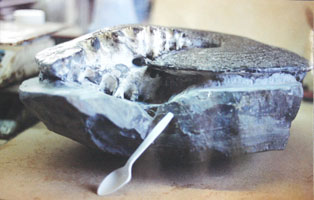
Original Placenticeras meeki - 7" spoon for scale
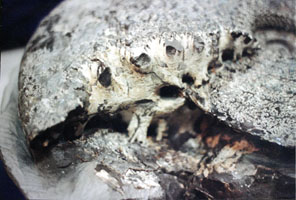
Close-up of septum wall of original specimen
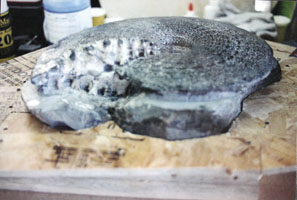
Original fossil with raised platform
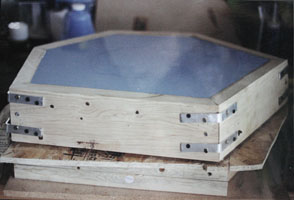
Mold frame and completely poured mold
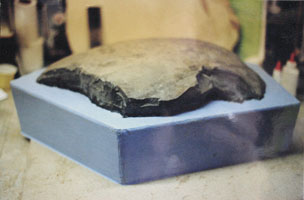
Mold with original still imbedded
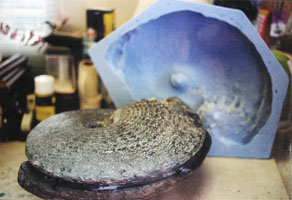
Original removed from mold
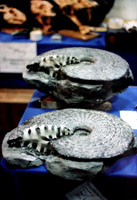
Original (back) and cast (front)